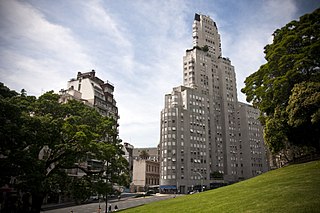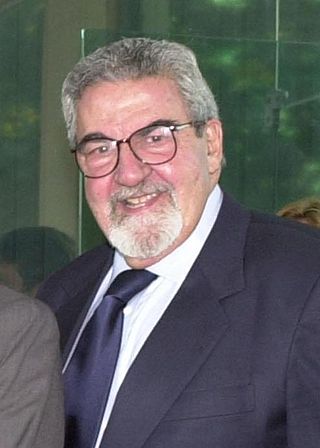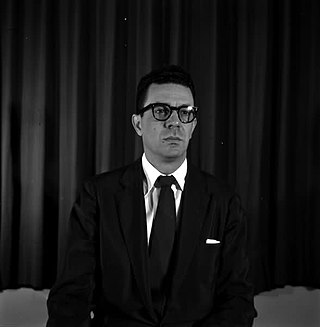Related Research Articles

Juan O'Gorman was a Mexican painter and architect.

Lúcio Marçal Ferreira Ribeiro Lima Costa was a Brazilian architect and urban planner, best known for his plan for Brasília.

Neomodern or neomodernist architecture is a reaction to the complexity of postmodern architecture and eclecticism in architecture, seeking greater simplicity. The architectural style, which is also referred to as New Modernism, is said to have legitimized an outlook of comprehensive individualism and relativism.

Guillermo Kahlo was a German-Mexican photographer. He photographically documented important architectural works, churches, streets, landmarks, as well as industries and companies in Mexico at the beginning of the 20th century; because of this, his work has not only artistic value but also historical and documental importance. He was the father of painter Frida Kahlo.
Max Ludwig Cetto was a German-Mexican architect, historian of architecture, and professor.

The Kavanagh Building is a residential skyscraper in Retiro, Buenos Aires, Argentina. Designed in 1934 by architects Gregorio Sánchez, Ernesto Lagos and Luis María de la Torre, it is considered a pinnacle of modernist architecture. At the time of its inauguration in 1936, the Kavanagh was the tallest building in Latin America surpassing the Palacio Salvo built in Montevideo, Uruguay in 1928, as well as the tallest building in the world with a reinforced concrete structure.
Luiz Fernando Carvalho is a Brazilian filmmaker and television director, known for works closely linked to literature that constitute a renovation in Brazilian audiovisual aesthetics. He has already brought to the screen works by Ariano Suassuna, Raduan Nassar, Machado de Assis, Eça de Queirós, Roland Barthes, Clarice Lispector, Milton Hatoum, José Lins do Rego and Graciliano Ramos, among others.
Jorge Glusberg was an Argentine author, publisher, curator, professor, and conceptual artist.

Many of Mexico's older architectural structures, including entire sections of Pre-Hispanic and colonial cities, have been designated World Heritage Sites for their historical and artistic significance. The country has the largest number of sites declared World Heritage Sites by UNESCO in the Americas.

Carlos Obregón Santacilia (1896–1961) was a Mexican art déco architect. He trained at the Academy of San Carlos during the Mexican Revolution. He claimed a distinguished Mexican heritage, as great grandson of Benito Juárez and grand nephew of Alvaro Obregón.
Brasília, the capital city of Brazil located in the nation’s Federal District, has a history beginning in the colonial era and interactions with the native inhabitants of the area. The first propositions of relocating Brazil's capital began in the late 18th century, and after various plans and attempts at settlement, the city was inaugurated on 21 April 1960 following a four year construction period. Since its inauguration, the city has faced economic, social and political challenges and has seen vast population growth and spreading urbanisation. Since the end of the 20th century, however, Brasília has become an important cultural hub through contributions of music, art and literature.

Rio Branco Avenue, formerly Avenida Central, is a major road in downtown Rio de Janeiro. It was built as the leading brand of the urban reform carried out by the mayor Pereira Passos in early 20th century.

Héctor Vigliecca (born 16 October 1940, in Montevideo) is an architect and urban planner naturalized Brazilian. He collects a vast production of work that includes social housing projects, arenas multi-use and buildings in the cultural, educational and institutional realm as well as large-scale urban projects. He is the founder of the architecture office Vigliecca & Associados established in São Paulo. Among the prominent projects are OUC Mooca-Vila Carioca, integrated studies in the area of 1.600 ha in São Paulo (SP), Castelão Arena, one of the venues of the 2014 FIFA World Cup in Brazil, Deodoro Olympic Park, the largest Olympic area of the Rio-2016, and Parque Novo Santo Amaro V, social housing project reference;

Luiz Paulo Fernández Conde was a Brazilian architect and politician. He was Mayor of Rio de Janeiro from 1997 to 2001 and Vice Governor from 2003 to 2007.
Luis Jose Antonio Miró Quesada Garland (1914-1994) was a Peruvian architect, professor, essay writer, art critic and a promoter of modern architecture in Peru. He played an important part in the process of change in Lima, from a society rooted in tradition and academic canon into a modern one. His actions were key to the social and urban changes, related to modern architecture and art, which happened during the 1940s. He died on 1994 at the age of 80 in Lima, Peru.
Marina Kitroser de Waisman was an Argentine architect, critic, and writer. She was awarded the Premio América in 1987.

The Califórnia Building is a mixed-use building in the República district of São Paulo, Brazil. It was designed by the architect Oscar Niemeyer (1907–2012) with Carlos Lemos. The building was designed in 1951 and completed in 1955. The Califórnia Building combined a gallery of retail space on its ground floor with residential units above, a theme common to Niemeyer's nearby Copan and Eiffel buildings. It sits on the corner of Barão de Itapetininga and Dom José de Barros avenues.
Town Planning Associates was a design firm in New York City, active between 1942 and 1959, which included Paul Lester Wiener, Paul Schulz, Josep Lluis Sert. The firm produced urban design and city planning in various new or existing South American cities including Bogotá, Chimbote in Peru, and Havana. Sert's master plan for Havana, Havana Plan Piloto, was notable for its integration of natural landscape into new urban and existing building schemes. Town Planning Associates made prominent use of patios and other aspects of Mediterranean architecture adapted to South and Central America. They employed modernist principles of the Congrès Internationaux d'Architecture Moderne (CIAM) and the Athens Charter. The charter got its name from the location of the fourth CIAM conference in 1933, which, due to the deteriorating political situation in Russia, took place on the SS Patris II bound for Athens from Marseilles. This conference was documented in a film commissioned by Sigfried Giedion and made by his friend László Moholy-Nagy "Architects' Congress." The Charter had a significant impact on urban planning after World War II and, through Josep Lluis Sert and Paul Lester Wiener, especially on the proposed modernization of Havana.

Sylvio Carvalho de Vasconcellos was a Brazilian architect and architectural historian, also recognized as one of the pioneers of Brazilian modernist architecture in the state of Minas Gerais.
Francisco Mujica was a Mexican architect. He developed a "neo-American" style of architecture.
References
- 1 2 Kimmelman, Michael (March 11, 2021). "How Can Blackness Construct America?". The New York Times.
- ↑ Longoria, Rafael (October 31, 2015). "Modern Architecture in Latin America: Art, Technology, and Utopia by Luis E. Carranza, Fernando L. Lara (review)". Arris. 26 (1): 70–71. doi:10.1353/arr.2015.0007. S2CID 244122836 – via Project MUSE.
- 1 2 3 4 5 6 "Fernando Lara". soa.utexas.edu.
- ↑ "Fernando Luiz Lara: A blown opportunity for Brazil". August 10, 2016.
- 1 2 Forty, Adrian (December 1, 2009). "Review: The Rise of Popular Modernist Architecture in Brazil, by Fernando Luiz Lara". Journal of the Society of Architectural Historians. 68 (4): 578–579. doi:10.1525/jsah.2009.68.4.578 – via online.ucpress.edu.
- ↑ Siwi, Marcio (November 1, 2018). "Modern Architecture in Latin America: Art, Technology, and Utopia". Hispanic American Historical Review . 98 (4): 753–754. doi:10.1215/00182168-7160688. S2CID 149680500. Archived from the original on November 1, 2022. Retrieved October 31, 2022.
- ↑ Siwi, Marcio (January 31, 2021). "The Making of New York's Avenue of the Americas: Transnational Circuits of Urban Renewal". Journal of Urban History. 47 (1): 85–110. doi:10.1177/0096144219864689. S2CID 201338691.
- ↑ Parra, Michael Andrés Forero (October 7, 2020). "Exhibir arquitectura en Colombia: una historia en construcción". Bitácora Arquitectura (44): 100–107. doi: 10.22201/fa.14058901p.2020.44.77156 . S2CID 225123543 – via www.revistas.unam.mx.
- ↑ "Modern Architecture in Latin America: Art, Technology, and Utopia | 2015-05-16 | Architectural Record". Architectural Record .
- ↑ Geraghty, Niall H.D.; Massidda, Adriana Laura (2019). "Introduction". Creative Spaces: 1–28. ISBN 9781908857484. JSTOR j.ctvp2n322.5.
- ↑ Dias, Valéria (January 23, 2020). Humanas, Ciências (ed.). "De capital da esperança à cidade com problemas: publicações trazem diferentes leituras de Brasília" (in Brazilian Portuguese). Retrieved October 31, 2022.
- ↑ Carranza, Luis E.; Lara, Fernando Luiz (November 3, 2021). "1957-b. Lina Bo Bardi, São Paulo Museum of Art". Modern Architecture in Latin America. University of Texas Press. pp. 208–209. doi:10.7560/758650-066. ISBN 9780292768178. S2CID 243775913.